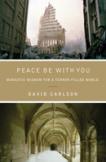A Different Path
In the wake of the terrorist attacks of Sept. 11, 2001, David Carlson wondered how monks and nuns had responded to the tragedy and if they possessed any special wisdom for the rest of us.
An Orthodox Christian who teaches religion at Franklin College in Indiana, Carlson decided to visit monasteries across the nation. The result is Peace Be With You, an inspiring and timely book published to coincide with the 10-year anniversary of the terrorist attack on the World Trade Center.
Carlson interviewed monastics in 2007 at the Benedictine Mona-stery of Christ in the Desert in New Mexico, the Catholic Sisters of Loretto Motherhouse in Kentucky, New Skete Orthodox Monastery in New York and several other religious communities.
During his research the author experienced an unexpected transformation, starting out angry and confused but gradually “waking to a new reality, where the divided worlds of enemy and friend have been replaced by only one category—the neighbor who has sacred value.”
Some monastics saw 9/11 as a missed opportunity to create a bridge of understanding to other nations that have experienced horrendous suffering. Many Americans chose instead a path of anger, hatred and vengeance that continues to this day. Regarding the killing of Osama bin Laden earlier this year, the author laments “images of people celebrating in the streets and jubilantly waving American flags.”
Carlson has a special affection for Thomas Merton and his fellow monks at Gethsemani Abbey in Kentucky. He refers to Merton’s often-cited epiphany while walking in downtown Louisville that “I loved all those people, that they were mine and I theirs, that we could not be alien to one another even though we were total strangers.”
For the Gethsemani Trappists, that message resonates today. They believe that “God is with us, lurking in the other, our neighbors, the very ones we wish to avoid” and, by extension, in the young men who flew planes into the World Trade Center.
Carlson discovered that monks and nuns generally care more about world affairs than do members of the general public. Too often, monastics believe, we fail to listen to what others are saying, assuming that we are always right and that God is on our side.
The choices after 9/11 were the same as God’s options at the crucifixion, when God rejected vengeance. “But in seeking to punish our enemies,” Carlson writes, “we leave Christ, we abandon Him, on the cross.”
Carlson comes across as a devout, open, inquisitive seeker. He readily admits his own frailties, including a period of severe depression after completing his research.
Peace Be With You may remind readers of the compelling 1999 book Beyond the Walls: Monastic Wisdom for Everyday Life, in which Paul Wilkes recounted the time he spent living with monks in Mepkin Abbey, a Trappist monastery in South Carolina, where he, too, learned that monastics have much wisdom to offer lay people.
Carlson believes that the 9/11 terrorists and Americans have something in common. “Both the U.S. government and al-Qaeda,” he writes, “have divided the world into two camps: civilization against evil. Both see peace in the world coming through the annihilation of the other. But since this is impossible, both seem to be promising unending warfare.”
Carlson spoke with a staff member at Richard Rohr’s Center for Action and Contemplation in New Mexico who responded to the U.S. invasion of Iraq by wondering how Americans would react if Iraq invaded the United States “for our good.”
This is not a perfect book. The portraits of individual monks and nuns are too brief to be memorable. The book also lacks an index and a list of the monasteries Carlson visited. But these are minor flaws in what otherwise is a compelling examination of America’s angry response to 9/11, along with the author’s discussion of a radical alternative that would have involved compassion, understanding, deep listening and forgiveness.
This article also appeared in print, under the headline “A Different Path,” in the September 19, 2011, issue.







